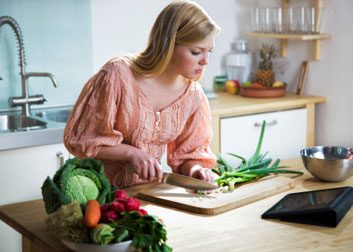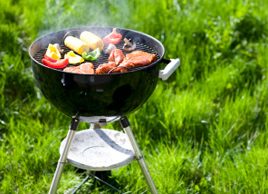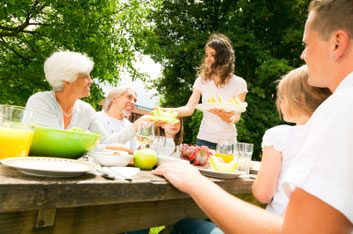
When preparing or eating food
Wash your hands! This is key to food safety. Before preparing or eating food, you should wash your hands for at least 20 seconds-or as long it takes to sing “Twinkle, Twinkle Little Star.” Hum the tune to yourself while you soap up, and have your kids do the same. Remind yourself and your family that hands have to be washed after touching any raw foods, after going to the bathroom or changing a diaper, and after playing in the sandbox. When soap and water aren’t available, use a hand sanitizer or antibacterial hand wipes.

On the road
If you’re driving to the cottage or taking a road trip, keep snacks and drinks in a small cooler bag or insulated foil bag (with a couple of frozen ice packs) for easy access. Cold foods must be kept below 4°C (40°F). Anything over 4°C is the “danger zone” where harmful bacteria start to grow. Depending on where you’re going and what you’re transporting, you may actually need a few different coolers. Foods you are taking to your destination and don’t need to access during the drive can be kept in a cooler in the trunk. Ideally, any raw meat should be packed in a separate cooler away from cooked food. If that’s not possible, make sure raw meat is completely sealed and place it at the bottom of the cooler to prevent any juices from dripping on top of the ready-to-eat food.
My go-to road-trip snacks and lunches are granola bars, nuts, cheese, fresh fruit, packaged fruit cups, juice, single-serving yogurts, single-serving cans of tuna with crackers, and sandwiches made with lean meat, cheese or peanut butter.

When barbecuing
I use two sets of barbecue tools; each includes a pair of barbecue tongs, a marinating brush and a cutting board. One set is for use with raw meat only; the other set is for handling cooked or ready-to-eat food only. I usually buy coloured utensils to use with raw food, and white ones to use with cooked foods. It’s an easy system to remember, and keeps me organized.
Also, always check the temperature of barbecued food. You can’t judge the doneness of food by its colour. For example, a hamburger might appear to be cooked inside but still contain harmful bacteria. Use a thermometer to check meat and poultry to make sure they’re cooked to a temperature high enough to kill bacteria that cause food poisoning. Ground beef burgers should be cooked to an internal temperature of 71°C (160°F), chicken breast to 74°C (165°F), and medium-rare steaks to 63°C (145°F). For a complete list of safe cooking temperatures, including seafood and egg dishes, go to befoodsafe.ca. Wash the thermometer after each reading.
When cleaning up after cooking raw meats, be sure to wash your dishes, cutting boards, utensils and countertops with hot soapy water. Then sanitize them with a bleach solution made from a mixture of one teaspoon (5 mL) of bleach and three cups (750 mL) of water.

At picnics and backyard parties
For cold foods, I bring a bag of ice cubes and pour them into a shallow dish. Then I place the salad bowl or entrée dish over the bowl of ice to keep the food cold while we’re eating. Frozen juice boxes can also double as ice packs around a serving dish, and then be enjoyed as cold drinks once they thaw.
And remember that within two hours, bacteria start growing in food that is left sitting out. Set a watch or cellphone alarm to remind you to refrigerate or pack up leftovers. If you’re not sure how long the food has been sitting out, play it safe and toss it.
Related:
• Garlic may have the power to kill bacteria that causes food poisoning
• 4 myths about food poisoning, busted
• 12 unhealthy health foods
